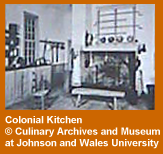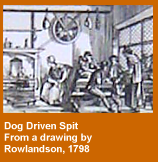
Turkey lore characterizes America. The founding fathers considered whether or not the wild turkey should be America's national emblem. While the wild turkey lost to the American bald eagle, turkey has continued to play roles in American folk-songs and slang. Turkey remains an enduring American food through association with Thanksgiving and with other holiday festivals, so much so that the average American eats nearly 15 pounds of turkey and turkey products annually.
WE GATHER TOGETHER
THE FIRST THANKSGIVING FEAST
The Pilgrims arrived off Cape Cod in 1620. Most of the Mayflower colonists were not farmers, nor were they hunters or fishers. There was little food that first year, but by fall 1621, the first crops were ready for harvest. The Plymouth colonists and 90 guests from the local Wampanoag Nation celebrated what has been called the First Thanksgiving. The feast lasted three days and included: venison, wild turkey and other wild fowl, bass, cod fish, and Indian corn [maize]. One text describing the First Thanksgiving is reproduced here, with its original 17th century English style and spellings?.
They begane now to gather in ye small harvest they had, and to fitte up their houses and dwellings against winter, being well recovered in health & strength, and had all things in good plenty; for some were thus imployed in affairs abroad, others were excersised in fishing, aboute codd, & bass, & other fish, of which yey tooke good store, of which every family had their portion. All ye somer ther was no wante. And now begane to come in store of foule, as winter approached, of which this place did abound. And besids water foule, ther was great store of wild Turkies, of which they took many, besids venison, &c. Besids they had aboute a peck a meale a weeke to a person. [2: 1]
COMING TO AMERICA
Items Needed to Establish a House and Farm:
Mault for making beere; hogshead of beefe or porke; 2-3 firkins of butter; 100-200 old cheeses; gallon of honey; wheate seede; [seeds] of rie, oates; barley; kernalls of pears and apples for making cider; stones and seeds of fruits, 1 iron pot; 1 iron kettle; 1 large frying pan; 2 skillets; 1 spit; platters, dishes, and wooden spoones. [2: 2]

PILGRIM TABLE MANNERS
Dinner was eaten off wooden platters called trenchers. Each trencher had a dinner side and a pie side, and it was proper to flip it over for dessert. Two people usually ate from the same trencher; but if a young man and a maiden shared, they were considered engaged. Napkins, knives and spoons were common, forks not. [2: 3]
COLONIAL COOKING: HEARTH AND HOME
Most food was prepared in a kettle and sweet pudding was cooked in the steam above the bubbling broth. Cast iron pans with long handles and three legs (spider skillets) were used for frying. Meats were commonly roasted and the spits were turned by hand. Sometimes, clever families put the family dog to work turning the spit! [2: 4]

WIDESPREAD EFFECTS OF DRINKING TEA OR COFFEE
Both coffee and tea have played significant roles in improving global health. In colonial times, water sources were often contaminated. To prepare a cup of coffee, or tea, water must be boiled. Boiling kills many types of germs that may be found in the water and the resulting beverage is safe to drink. [2: 5]
PASSENGER PIGEON AND BIRD HUNGER
Passenger pigeons were once so abundant their numbers were estimated in the billions. Some accounts say that during their migration the sky darkened at mid-day. When flocks landed in a field, they quickly devoured the grain and destroyed the harvest. The resulting food shortage was called 'bird hunger.' [2: 6]
A MOVEABLE FEAST
George Washington declared Thursday, November 26th, 1789, the first national Thanksgiving holiday. Over the years, presidents chose different days for the holiday. President Madison established April 13th, 1815. In 1863 Abraham Lincoln proclaimed the fourth Thursday in November, while in 1939 President Franklin D. Roosevelt declared the third Thursday of November. Congress passed a Joint Resolution in 1941 that returned Thanksgiving to the fourth Thursday of November..... where the celebration remains today. [2: 7]
1565 St. Augustine settlement, Florida (Spanish)
1584 Roanoake settlement, Virginia (English)
1607 Jamestown settlement, Chesapeake Bay (English)
1621 First Thanksgiving feast
1627 Nieuw Amsterdam settlement, New York (Dutch)
1702 First coffee house in America, Philadelphia
1762 Sandwich invented (England)
1773 Boston Tea Party
1775 American War of Independence begins
1776 Declaration of Independence (July 4th)